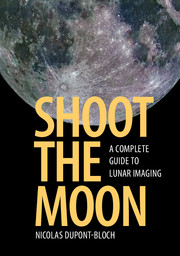
- Publisher:
- Cambridge University Press
- Online publication date:
- September 2016
- Print publication year:
- 2016
- Online ISBN:
- 9781316392843
Last updated 10th July 2024: Online ordering is currently unavailable due to technical issues. We apologise for any delays responding to customers while we resolve this. For further updates please visit our website https://www.cambridge.org/news-and-insights/technical-incident


The Moon boasts an unexpected variety of landscapes - including volcanic features, sinuous valleys and ghost craters - which are readily visible from Earth. This practical guide explains and demonstrates how you can capture impressive images of our nearest neighbour in space using a variety of different techniques. As the first guide to be dedicated to modern lunar imaging, this volume offers an in-depth and illustrated approach to common optics, the essentials of digital images, imaging devices, and image processing software. Even in light-polluted areas, the countless features and finest details of the Moon can be captured by following the instructions in this comprehensive and accessible guide. Covering equipment ranging from smartphones and DSLRs to specialist planetary cameras, whether you are a novice without a telescope, an amateur developing your skills in imaging, or an experienced astrophotographer, you will benefit from the hints, insights and expertise within.
'Dupont-Bloch, an author and amateur astronomer, reminds the reader that the moon is a beautiful object with a huge variety of geologic features that can be seen from even the most light-polluted urban location … Have a smartphone or a cheap webcam? If yes, then one is ready to shoot the moon. Thinking about buying a DSLR camera or interested in a high-end CCD imager? This book will help one make the right choice. Want to learn how to make images with the best focus, get good contrast and color balance, take stereo images of the moon, find the Apollo landing site, or even shoot video of lunar impacts? This book shows 'how-to'. The work will be most useful to the serious amateur, but novices will find enough background to get up to speed with a little help from the numerous references and excellent lunar charts that are provided.'
T. D. Oswalt - Embry-Riddle Aeronautical University, Daytona Beach
'[The book] covers the use of a wide range of equipment in all possible permutations, from phone cameras, consumer cameras, and standard lenses, up to the usual amateur CCD and CMOS cameras coupled to equatorially-mounted telescopes. The subject is treated with some humour (or quirkiness), with features like tables of methods where levels of difficulty are represented by social-media-type ‘smiley’ icons … This is the most thorough and detailed book covering the whole subject of lunar imaging I have yet seen. …'
David Arditti Source: The Observatory
 Loading metrics...
Loading metrics...
* Views captured on Cambridge Core between #date#. This data will be updated every 24 hours.
Usage data cannot currently be displayed.